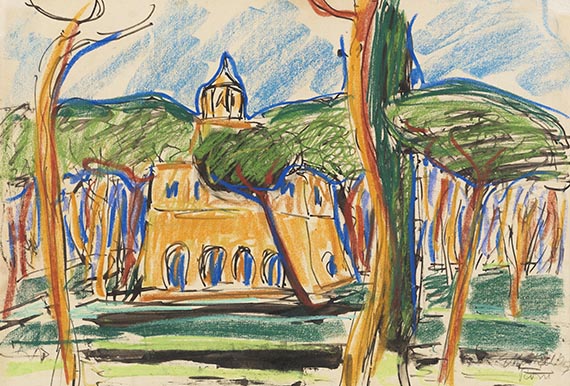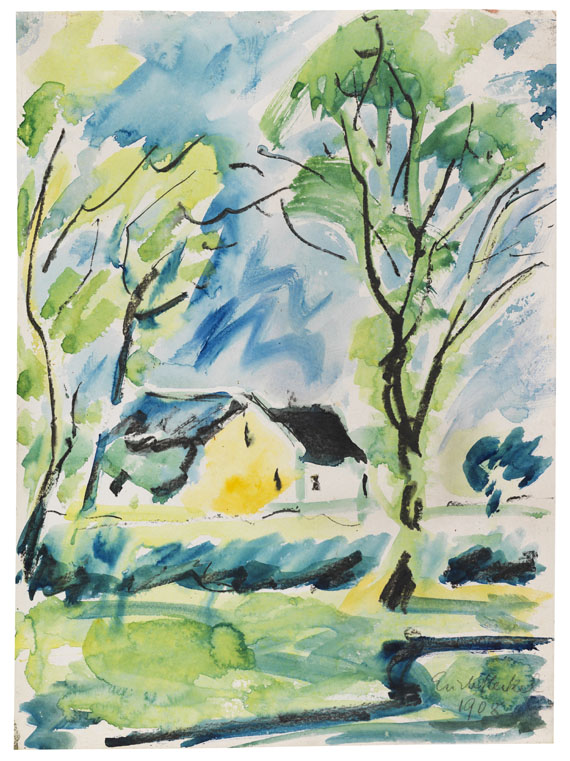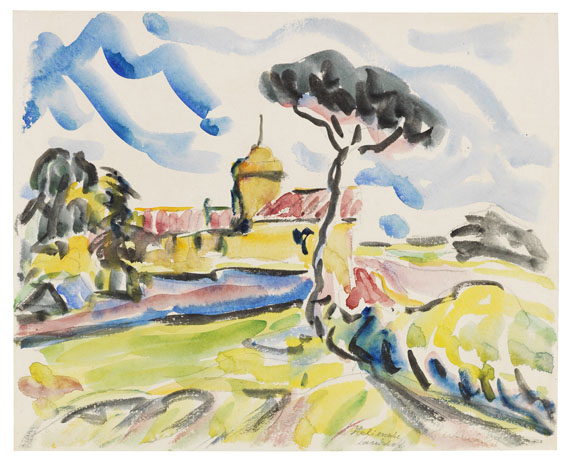218
Erich Heckel
Villa Borghese in Rom, 1909.
Color chalks over India Ink drawing
Post auction sale: € 25,000 / $ 29,500
Villa Borghese in Rom. 1909.
Color chalks over India Ink drawing.
Signed, dated, and inscribed “Rom” in the lower right corner. On laid paper. Ca. 34.3 x 48.2 cm (13.5 x 18.9 in), the full sheet.
With a second, barely recognizable drawing on the reverse, probably the impression of another chalk drawing by the artist. [AR].
• The Villa Borghese, symbol of the artistic heritage of the Eternal City, becomes a motif for the German Expressionist.
• With great ease and liberated lines, Erich Heckel captures the Italian scenery and transfers it to a new era and understanding of art.
• The Brücke Museum in Berlin has similar works from Heckel's trip to Italy in 1909, which are imbued with the light of the South and the vigor of the then still young artist.
The work is registered in the Erich Heckel Estate, Hemmenhofen on Lake Constance. We are grateful to Ms. Renate Ebner and Mr. Hans Geissler for their kind support in cataloging this lot.
PROVENANCE: Erich and Siddi Heckel Collection (at least until 1964).
Wolfgang Wittrock, Berlin.
Private collection, Great Britain (acquired from the above in 2002).
EXHIBITION: Erich Heckel. Gemälde, Aquarelle, Zeichnungen und Graphik aus dem Privatbesitz des Künstlers, Fränkische Galerie am Marientor, Nuremberg, Jan. 10–Feb. 9, 1964, cat. no. 49 (illustrated on the cover).
LITERATURE: Kornfeld & Klipstein, Bern, auction 145, June 15-17, 1972, lot 384 (illustrated).
Color chalks over India Ink drawing.
Signed, dated, and inscribed “Rom” in the lower right corner. On laid paper. Ca. 34.3 x 48.2 cm (13.5 x 18.9 in), the full sheet.
With a second, barely recognizable drawing on the reverse, probably the impression of another chalk drawing by the artist. [AR].
• The Villa Borghese, symbol of the artistic heritage of the Eternal City, becomes a motif for the German Expressionist.
• With great ease and liberated lines, Erich Heckel captures the Italian scenery and transfers it to a new era and understanding of art.
• The Brücke Museum in Berlin has similar works from Heckel's trip to Italy in 1909, which are imbued with the light of the South and the vigor of the then still young artist.
The work is registered in the Erich Heckel Estate, Hemmenhofen on Lake Constance. We are grateful to Ms. Renate Ebner and Mr. Hans Geissler for their kind support in cataloging this lot.
PROVENANCE: Erich and Siddi Heckel Collection (at least until 1964).
Wolfgang Wittrock, Berlin.
Private collection, Great Britain (acquired from the above in 2002).
EXHIBITION: Erich Heckel. Gemälde, Aquarelle, Zeichnungen und Graphik aus dem Privatbesitz des Künstlers, Fränkische Galerie am Marientor, Nuremberg, Jan. 10–Feb. 9, 1964, cat. no. 49 (illustrated on the cover).
LITERATURE: Kornfeld & Klipstein, Bern, auction 145, June 15-17, 1972, lot 384 (illustrated).
218
Erich Heckel
Villa Borghese in Rom, 1909.
Color chalks over India Ink drawing
Post auction sale: € 25,000 / $ 29,500
Buyer's premium, taxation and resale right compensation for Erich Heckel "Villa Borghese in Rom"
This lot can only be purchased subject to regular taxation, artist‘s resale right compensation is due.
Regular taxation:
Hammer price up to 800,000 €: herefrom 27 % premium.
The share of the hammer price exceeding 800,000 € is subject to a premium of 21% and is added to the premium of the share of the hammer price up to 800,000 €.
The share of the hammer price exceeding 4,000,000 € is subject to a premium of 15% and is added to the premium of the share of the hammer price up to 4,000,000 €.
The statutory VAT of currently 7 % is levied to the sum of hammer price and premium.
Calculation of artist‘s resale right compensation:
For works by living artists, or by artists who died less than 70 years ago, a artist‘s resale right compensation is levied in accordance with Section 26 UrhG:
4 % of hammer price from 400.00 euros up to 50,000 euros,
another 3 % of the hammer price from 50,000.01 to 200,000 euros,
another 1 % for the part of the sales proceeds from 200,000.01 to 350,000 euros,
another 0.5 % for the part of the sale proceeds from 350,000.01 to 500,000 euros and
another 0.25 % of the hammer price over 500,000 euros.
The maximum total of the resale right fee is EUR 12,500.
The artist‘s resale right compensation is VAT-exempt.
Regular taxation:
Hammer price up to 800,000 €: herefrom 27 % premium.
The share of the hammer price exceeding 800,000 € is subject to a premium of 21% and is added to the premium of the share of the hammer price up to 800,000 €.
The share of the hammer price exceeding 4,000,000 € is subject to a premium of 15% and is added to the premium of the share of the hammer price up to 4,000,000 €.
The statutory VAT of currently 7 % is levied to the sum of hammer price and premium.
Calculation of artist‘s resale right compensation:
For works by living artists, or by artists who died less than 70 years ago, a artist‘s resale right compensation is levied in accordance with Section 26 UrhG:
4 % of hammer price from 400.00 euros up to 50,000 euros,
another 3 % of the hammer price from 50,000.01 to 200,000 euros,
another 1 % for the part of the sales proceeds from 200,000.01 to 350,000 euros,
another 0.5 % for the part of the sale proceeds from 350,000.01 to 500,000 euros and
another 0.25 % of the hammer price over 500,000 euros.
The maximum total of the resale right fee is EUR 12,500.
The artist‘s resale right compensation is VAT-exempt.
Headquarters
Joseph-Wild-Str. 18
81829 Munich
Phone: +49 89 55 244-0
Fax: +49 89 55 244-177
info@kettererkunst.de
Louisa von Saucken / Undine Schleifer
Holstenwall 5
20355 Hamburg
Phone: +49 40 37 49 61-0
Fax: +49 40 37 49 61-66
infohamburg@kettererkunst.de
Dr. Simone Wiechers / Nane Schlage
Fasanenstr. 70
10719 Berlin
Phone: +49 30 88 67 53-63
Fax: +49 30 88 67 56-43
infoberlin@kettererkunst.de
Cordula Lichtenberg
Gertrudenstraße 24-28
50667 Cologne
Phone: +49 221 510 908-15
infokoeln@kettererkunst.de
Hessen
Rhineland-Palatinate
Miriam Heß
Phone: +49 62 21 58 80-038
Fax: +49 62 21 58 80-595
infoheidelberg@kettererkunst.de
We will inform you in time.




 Lot 218
Lot 218 


